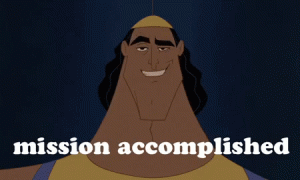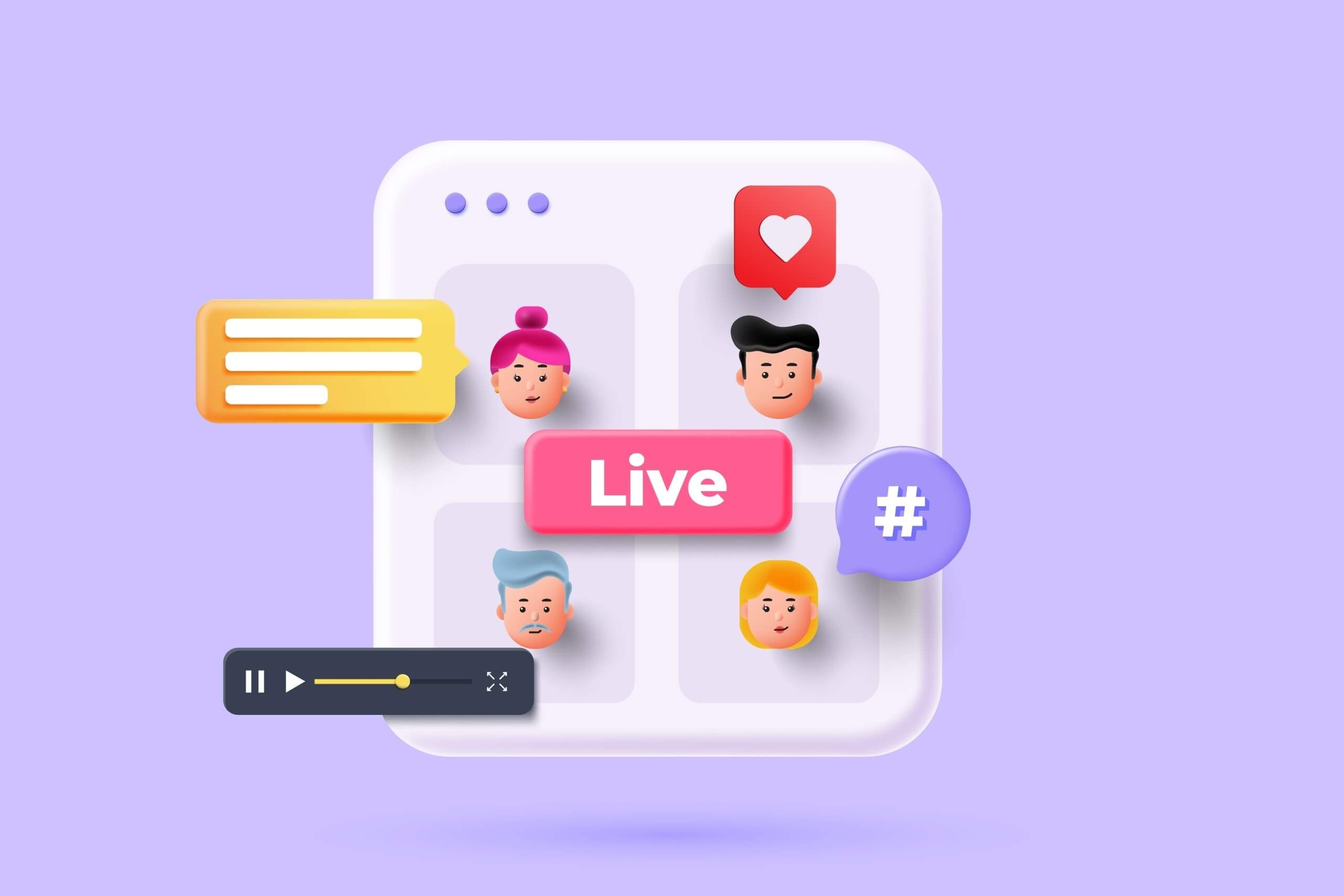Want a heads up when a new story drops? Subscribe here.
Table of Contents
Welcome Back!
Coming straight from Part I оf our event marketing guide? Welcome back! Now that you know the essence of event marketing, the most common event types, their pros and cons, and the must-have checkpoints for throwing an event, it’s time to delve more into strategies. In this part, we will shed more light on the approaches we’ve been using, time-tested tactics that have proven effective and upcoming trends that are here to stay. Brace yourself for a wild but educational ride. It’s time to learn how to rock your next event!
How to Create a Successful Event Marketing Strategy?
Time to get serious! Wondering what to focus on for your event marketing strategy? Here are our recommendations:
Share Press Release With the Media
Let’s talk a little bit about one of the most efficient ways to get some attention and media coverage for any event – press releases. Press releases serve as a concise and compelling announcement to the media, providing essential information about your event and generating interest among journalists, influencers, and potential attendees.
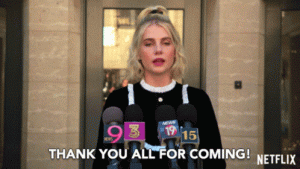
No, it doesn’t have to be like that. We will tell you how to do it a bit. Let us first explain why press releases are beneficial, and how they can help your event.
Generate Buzz and Awareness
First and foremost, a well-crafted press release can generate buzz and create awareness about your event. That’s its first purpose. By sharing exciting details, such as keynote speakers, unique features, or exclusive announcements, you can capture the attention of media outlets and potential attendees.
The press release is an official statement that amplifies your event’s message and builds anticipation. It can pique curiosity and generate interest, ultimately leading to increased event awareness and attendance.
Media Coverage
One of the primary benefits of issuing a press release is the potential for media coverage. When journalists and media outlets receive your press release, they may opt for featuring your event in articles, interviews, or news segments. This coverage can attract a broader audience, increase credibility, and enhance the overall reputation of your event – all something you definitely want.
And if you wish to reach a wider audience through trusted media channels and expose your event to individuals who may not have been aware of it otherwise, a press release is what you need.
SEO Benefits
We don’t know how much effort you put into your SEO game, hopefully, a lot, but publishing a press release online can contribute to your event’s search engine optimization (SEO). By including relevant keywords and links to your event website and press release page and sharing them on various platforms, you can improve your event’s online visibility and increase organic traffic to your website.
The search engine can index your press release, optimizing the content, which can help improve your event’s search engine rankings. That means that when people search for relevant keywords or topics related to your event, your press release has the potential to appear in search results, driving more traffic to your event website.
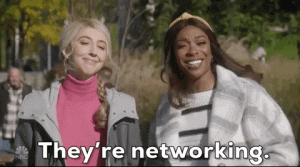
Networking Opportunities
Press releases can help you connect with relevant industry influencers, journalists, and potential event partners. Media professionals who come across your press release may reach out for interviews, feature stories, or seek collaboration opportunities. That can lead to valuable networking connections and partnerships that can further enhance the success of your event. By leveraging the exposure gained through press release coverage, you can forge meaningful relationships and collaborations with key players in your industry, expanding your reach and influence.
Establish Thought Leadership
A well-crafted press release allows you to position yourself or your organization as a thought leader in your industry or niche. You can demonstrate your knowledge and expertise by including insightful quotes, expert opinions, or industry trends related to your event. That can attract media attention and establish your event as a reputable source of valuable insights and information.
How to Write a Compelling Press Release

Don’t worry! Writing a compelling press release is not as difficult as it might seem. While typically not involved in a regular content marketing strategy, there’s not much difference to other forms of content you might be producing. Here are some tips and guidelines to help craft a press release that effectively promotes your event.
Start with a strong headline.
What better way to grab the reader’s attention than with a captivating headline that conveys the essence of your event and sparks curiosity? Make it concise, informative, and engaging to entice readers to delve further. If it corresponds with your brand identity, add a little humor to the headline, readers will appreciate it. Here is an example to inspire you:
- “Fashion Rebels Unite! [Brand Name] Unleashes Guilt-Free Glamour with a Sustainable Fashion Collection That’ll Make Mother Nature Blush”
Provide a clear and concise summary.
Follow the headline with a summary paragraph that provides an overview of your event. Highlight the key details, such as the event’s purpose, date, location, and any notable speakers or performers. This summary should give readers a snapshot of what to expect. Here’s an example summary of our fictional fashion brand.
- Get ready to witness a fashion revolution like never before as we unveil our game-changing sustainable fashion collection to the world. Join the fashion rebels on [Date] at [Location] for an unforgettable event that combines glamor, sustainability, and a daring spirit. Here to show our commitment to creating fashion that doesn’t compromise our planet, be prepared to be awed by innovative designs crafted with sustainable materials and produced through ethical practices. It’s time to make Mother Nature blush with pride as we redefine the future of fashion. Don’t miss this extraordinary opportunity to be part of the movement that’s transforming the industry. Save the date, and join us for a night that will inspire, captivate, and revolutionize the way you view fashion.
Craft an engaging lead paragraph.
The opening paragraph should expand on the summary and draw readers in with compelling information. Use vivid language to highlight the unique aspects of your event, its significance, and the value it offers attendees.

Incorporate quotes.
Include quotes from event organizers, keynote speakers, or industry experts to add credibility and humanize the press release. They can provide unique insights, express enthusiasm, or explain the event’s significance, lending a personal touch.
- “We are thrilled to introduce the [Brand Name], a revolutionary game-changer in our industry,” said [Spokesperson], [Job Title] at [Corporation]. “This event is a unique opportunity for attendees to experience firsthand how [Brand Name] will transform [Target Market] and shape the future of [Industry].”
Highlight unique selling points.
Emphasize what sets your event apart from others in the industry. Showcase any exclusive features, innovative approaches, or compelling reasons why attendees should participate. Highlight the benefits and value they can expect.
- In our hypothetical example, our unique selling points would be sustainability in fashion, ethical process, eco-friendliness, and revolutionizing the fashion industry.
Provide essential event details.
In subsequent paragraphs, provide more details about your event. Include information on the agenda, guest speakers, workshops, special activities, or any exciting elements that make your event stand out.
- Even if our hypothetical example is of a fashion show, there could be a workshop explaining how to use sustainable materials to create a fashion garment or a seminar discussion explaining the benefits of switching to more ethical and sustainable practices.
Focus on relevance.
Clearly articulate why your event is relevant to the target audience. Highlight the industry trends, challenges, or opportunities your event addresses and how it can help attendees stay ahead in their field.
- You could mention that renowned industry experts and influencers will be in attendance, providing valuable insights and sharing their experiences.
Include contact information.
Provide contact details for media inquiries, such as a designated spokesperson’s name, email address, and phone number. Make it easy for journalists to reach out for more information or to arrange interviews.
- To learn more about [Brand Name] and reserve your spot at this exclusive showcase, visit [Event Website]. For media inquiries or interview requests, please contact [Contact Person] at [Email Address] or [Phone Number].
Proofread and revise.
That point should be a mandatory step of your pre-release process for any content type you release on- or offline, but let’s mention its importance briefly again. Before distributing the press release, meticulously proofread it for grammar, spelling, and formatting errors. Ensure that the information is accurate, consistent, and flows smoothly. A meticulously crafted press release showcases professionalism and thorough attention to detail.
Effective Pre-event Promotions
One of the most significant aspects of pre-event promotions is creating a comprehensive marketing plan encompassing various channels and tactics. Leveraging email marketing could be a hidden gem that would make your event the star it is supposed to be.
Building an email list of interested individuals and sending them regular updates, exclusive offers, and reminders can create a sense of exclusivity and urgency. Consider segmenting your email list based on interests or demographics to personalize the content and improve engagement.

Offering early-bird discounts, exclusive perks, or limited-time promotions can create a sense of urgency and encourage early registration. FOMO can quickly play in your favor if you learn how to use it right. People love getting special deals or being part of something exclusive, so leverage these incentives to drive early ticket sales and generate momentum for your event.
Еffective pre-event promotions require careful planning, creativity, and a deep understanding of your target audience. By implementing a well-rounded marketing strategy, utilizing various channels, and creating engaging content, you can build excitement, generate interest, and ensure a triumphant turnout for your event.
Get Influencers to Promote Your Event
The influencer market in the US was worth a record 16.4 billion in 2022. Some might still deny influencers’ immense power, but more and more brands have started to catch the influencer marketing wave.
Collaborating with influencers can help increase your event’s reach, credibility, and engagement. Those who work with influencers have higher chances of hosting more successful and profitable events. But why?
Influencers have built a loyal following and have established themselves as authorities in their respective niches. They sway opinions, shape trends, and influence purchasing decisions. Sounds like the dream, right?
By partnering with influencers, you can tap into their existing audience, leverage their credibility, and reach a larger and more targeted audience for your event.
Furthermore, influencers bring authenticity and a personal touch to their content, which resonates with their audience and builds trust. Lastly, influencers often have expertise in content creation, allowing them to produce compelling and creative promotional materials that can generate excitement for your event.
But can all influencers work for you? The short answer is No. Let us explain. If you are throwing a tech conference, would you invite a lifestyle influencer or a tech-savvy one? To maximize the attending influencers’ impact, they must align with your event’s theme, target audience, and brand values.

Look for influencers with a genuine interest in your industry or event topic. Consider their content style, engagement rates, and the relevance of their audience. There are different influencer segments – some have large followings, and others are just starting and thus have a much smaller reach.
Yet, micro-influencers, as we call them, might bring much better results for niche events. They usually have highly engaged audiences, which listen closely and interact strongly with the influencers’ thoughts, opinions, and content.
So when working with influencers, a high following count doesn’t always mean better results. The four pillars of a successful influencer marketing campaign are:
- Segmentation – Always pick the influencers that are in your niche. You don’t need people that have no thorough understanding of the theme and topics of your event.
- Research – Before signing a contract, perform thorough research on the influencer. Check engagement rates, availability, and pricing rates.
- Influencer type – Even niche influencers belong to different groups. Mega-influencers would charge you more than micro-influencers.
- Budget – Don’t forget your budgeting plan. How much can you spend on influencers? Don’t go overboard paying for influencers that are way out of your budget range. Do some research and find options within your budget.
Adopt a thoughtful, personalized, and thoroughly planned approach to steer clear of common influencer marketing mistakes. Start by following them on social media, engaging with their content, and building a genuine connection. Reach out to them with a personalized message expressing your admiration for their work and explaining how your event aligns with their interests and values. Offer them unique opportunities, such as exclusive access, VIP treatment, or co-creation of content to incentivize their participation.
As with anything else, maintaining transparency is crucial for a successful collaboration. It ensures that influencers disclose their partnership with your event to comply with ethical guidelines and maintain transparency with their audience. Also, establish clear guidelines for the collaboration, including content requirements, key messaging, and performance metrics.
Coachella and Influencer Marketing
Coachella, the renowned music and arts festival held annually in Indio, California, continues to draw a plethora of influencers each year to amplify its reach and create a buzz around the event. These influencers play a significant role in promoting Coachella to their massive online following, thus attracting a wider audience and generating increased interest in the festival.
In recent years, Coachella has strategically collaborated with influential personalities from the worlds of fashion, music, and entertainment. Kylie Jenner, an internationally recognized social media influencer and entrepreneur, has been the occasional Coachella attendee.
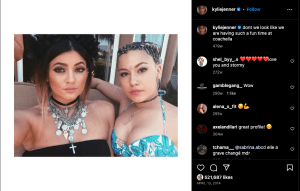
Yet, one notable example is her attendance at Coachella in 2019, which caused a significant stir on social media, with her posts and stories capturing the attention of millions of followers and showcasing the festival’s vibrant atmosphere, fashion trends, and performances.
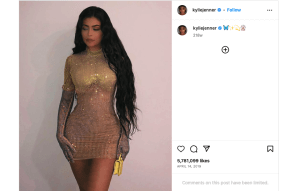
Another influential figure who has graced Coachella is Chiara Ferragni, a prominent fashion influencer and entrepreneur. Her appearances at the festival have garnered substantial media coverage and generated excitement among her followers. Ferragni’s posts featuring her festival outfits, behind-the-scenes moments, and performances by renowned artists have further solidified Coachella’s status as a must-attend event for music and fashion enthusiasts.
Don’t even get us started on her notable collaboration with the fashion brand Revolve, with Ferragni tagging the brand’s accounts on social media on numerous Coachella posts.
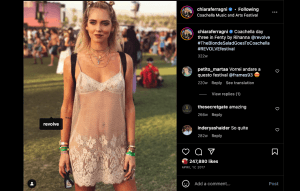
These examples highlight the ongoing efforts by Coachella organizers to collaborate with influential individuals with a strong presence on social media platforms. By inviting high-profile influencers such as Kendall Jenner and Chiara Ferragni, Coachella gains significant exposure to a massive global audience. These influencers’ posts, which showcase the festival’s unique atmosphere, fashion trends, and performances, serve as social proof and powerful endorsements that entice their followers to attend and participate in the Coachella experience.
It is worth noting that Coachella’s influence extends beyond individual influencers. The festival has become a cultural phenomenon, with countless attendees and influencers from various backgrounds flocking to the event each year. This convergence of influencers creates a unique social media ecosystem where content creators, fashion enthusiasts, and music lovers share their experiences, collaborate on content, and further amplify Coachella’s presence across different online platforms.
Create a Strong Landing Page
When you throw an event, you want people to have access to as much information as possible, yet you want to present it in a compelling, engaging, and innovative manner. With that in mind, creating a solid landing page should be another priority on your list.
A well-crafted landing page is like the online gateway for potential attendees, providing them with essential information, generating excitement, and ultimately driving conversions. It can capture visitors’ attention, convey the event’s value proposition and compel readers to take action.
First and foremost, a one-of-a-kind landing page helps create a lasting first impression. It sets the tone for the event and showcases the brand’s professionalism and attention to detail. The landing page should reflect the event’s theme, atmosphere, and unique selling points, capturing the essence of what makes it exceptional.

Thoughtful design choices, captivating visuals, compelling copy, and engaging multimedia elements are just a couple of the things your design team should do when generating the page.
We’ve designed plenty of websites and landing pages in our time, so let us tell you what always works. Simplicity and clarity work like a charm every single time. Your landing page should have a clean and intuitive layout that guides visitors’ attention to the most essential information.
A clear headline and subheadings can quickly communicate the event’s purpose and value proposition. Use visually appealing graphics, such as high-quality images or videos, and colors that evoke the desired emotions and convey the right message and the event’s atmosphere.
Usually, brands use the same colors that are part of their branding playbook to create consistency across all platforms and marketing channels. Incorporate strong call-to-action (CTA) buttons or forms that make it easy for visitors to register or purchase tickets.
Furthermore, a well-optimized landing page improves search engine visibility and increases organic traffic. Implementing relevant keywords, meta tags, and descriptive URLs can enhance the page’s search engine optimization (SEO), making it easier for potential attendees to find the event through online searches.
Last but not least – put the user experience first. You want visitors to find what they are looking for in an instant and without any hesitation. With that in mind, as an increasing number of people access the internet and make purchasing decisions through their smartphones or tablets, ensuring the landing page is mobile-friendly is a must.
Let’s explore some examples of brands that have created exceptional landing pages for their events:
- Apple – Apple’s annual Worldwide Developers Conference (WWDC) is known for its beautifully designed landing page. The page incorporates stunning visuals, concise and impactful copy, and an easy-to-navigate layout, allowing developers to pinpoint event details, schedule, and registration information quickly.
- DreamHack – DreamHack, one of the world’s largest digital festivals, features an immersive landing page that showcases the event’s gaming, esports, and digital culture elements. The page incorporates captivating visuals, event highlights, and clear calls to action, catering to the gaming community.
- Microsoft Ignite – Microsoft Ignite, a technology conference, boasts a visually stunning landing page that aligns with the brand’s modern and innovative image. The page features a video backdrop, and concise event details, emphasizing the event’s focus on empowering individuals and organizations through technology.
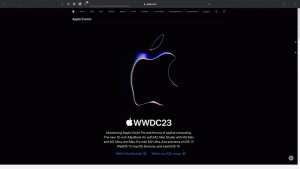
Social Media Management
Should we even talk about utilizing social media? The very same thing that has revolutionized event marketing, providing a powerful platform to generate buzz, engage with attendees, and expand the reach of an event?
You probably know that effective social media management is crucial for creating a strong online presence, fostering meaningful interactions, and generating earned media. Then why aren’t you using it to boost your event and secure its success? Here’s an in-depth look at how to leverage social media for successful event promotion.
If you still haven’t, select the appropriate social media platforms that align with your target audience and event objectives. Different platforms cater to diverse demographics and user behaviors. For example, LinkedIn may be more suitable for B2B and other more professional events, while Instagram and TikTok could be efficient for reaching younger demographics.
Yet that doesn’t necessarily mean that TikTok and Instagram might not be beneficial for you anyway. It is all about research and understanding one’s audience.
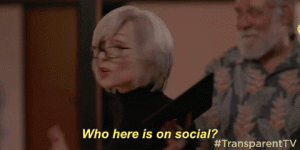
Develop a comprehensive content strategy that aligns with your event’s messaging and goals. Create a mix of engaging and informative content, including event updates, behind-the-scenes sneak peeks, speaker highlights, attendee testimonials, and interactive elements like polls and contests.
Engagement is crucial to building a thriving online community. Actively respond to comments, questions, and user-generated content. Show appreciation for attendees’ posts by resharing or featuring them on your social media channels. That fosters a sense of inclusivity and encourages further engagement.
You can even use your social media for live streaming your event or certain parts of it, like a highly anticipated lecture by a notable speaker in your industry. Social media platforms’ live-streaming features are getting better with every app update. Reach a wider audience and engage with those who couldn’t attend in person.
User-generated content is a valuable asset for event promotion. Encourage attendees to create and share content related to your event, such as photos, videos, testimonials, or reviews. Creating a unique user-generated content campaign is by no means an easy task. It requires a great understanding of your target audience and its needs. Yet, when done right, it boosts attendee engagement and creates authentic content that can attract new attendees for free.
Monitor and measure your social media efforts using analytics tools. To evaluate the effectiveness of your social media strategy, track metrics like engagement rate, reach, clicks, and conversions.
As far as examples go, we could literally go on forever. That is simply because every brand leverages social media to promote events. Be it for sharing updates, showcasing exclusive content, engaging with respective communities, lifting the curtains with some behind-the-scenes content, or collaborating with influencers, don’t skip on social media marketing.
Content Marketing
Just like your website and social media posts require top-notch short- and long-format, your event’s landing page and all promotional formats you have chosen need to be perfectly written as well.
Visual elements draw people’s attention to you, and well-written content will retain them, stimulating their interest further and making them convert by buying a ticket. It basically positions your event as a must-attend experience. Or not.
Having your goals figured out, you can focus on your messaging. There are several content marketing tactics you could try.
Determine the types of content that will resonate with your target audiences, such as blog posts, explainer videos, infographics, podcasts, or case studies. Align your content strategy with your event’s value proposition and desired outcomes.
Next, it is creation time. Generate engaging content that provides value to your audience. You’ve probably heard this before, but we will never get tired of repeating the immense significance value has on readers.
Depending on your niche and industry, “value” might be a relatively fluctuating term. Yet, thought leadership articles, expert interviews, educational resources, success stories, or sneak peeks into event preparations always do wonders. Utilize written and visual storytelling techniques to make your content captivating and memorable.
Don’t forget when creating your content to make it SEO-friendly. Do keyword research and all other SEO techniques that will elevate your content. When producing your texts, consider keyword density and never overstuff them with keywords. It sounds fake and will do you more harm than good.
Before signing up or paying for a professional event, which usually costs a lot, people need to convince themselves they are putting their time and money into worth. They want to see your expertise. Maintain an active blog that covers relevant industry topics, event updates, and insights from speakers or industry experts.
You can even encourage guest blogging from industry influencers to broaden your reach. You want people to see you as an expert in your field. So start thinking outside the box and step up your content marketing game.
You can present your written content in a variety of ways. Utilizing visually appealing content formats such as videos, infographics, animations, and images to capture attention and communicate your event’s unique selling points will elevate your game to the next level.
Whatever you write, in whatever format you post it, make sure it aligns with your brand identity, values, and audience. For example, for strictly formal brands, jargon words, and collocations might not be the best idea. Yet, if you are a brand targeting teenagers, slang, humor, and sarcasm might be exactly what you need.
Learn to speak your audience’s language. Whether it’s Shakespearean-level English or Gen-Z slang, talk to those you want to attract, and you will always reach them.

Paid Channels
Sometimes brands rely on paid channels to further elevate their event marketing strategy. These channels allow you to leverage paid advertising and promotional tactics to amplify your event’s reach and generate valuable results.
One of the key advantages of using paid channels is the increased reach and targeting capabilities they offer. With paid advertising, you can access a vast network of users and target specific demographics, interests, and behaviors.
This targeted approach ensures that your event promotions are reaching the right audience, increasing the likelihood of attracting attendees who are genuinely interested in your event.
In addition, to reach, paid channels provide enhanced brand visibility. By investing in paid advertising, you can secure premium placements on search engine result pages, social media platforms, industry websites, and event directories. Some brands go even further and promote their events through traditional marketing channels, such as TV ads or billboards. The increased visibility makes your event more prominent and memorable, leading to greater attendance and participation.
Another significant benefit of utilizing paid channels is the ability to achieve quick results and an immediate impact. Unlike organic marketing efforts that take time to gain traction, paid advertising allows you to launch campaigns quickly and drive traffic to your event website, landing page, or registration page almost instantly. This agility is especially valuable when promoting time-sensitive offers, early bird ticket sales, or limited-time promotions.
Paid channels also offer precise tracking and analytics capabilities, allowing you to measure the effectiveness of your campaigns and optimize your marketing efforts. By tracking key metrics such as impressions, clicks, conversions, and return on investment (ROI), you can gain valuable insights into the performance of your ads. These insights enable you to fine-tune your targeting, messaging, and ad placements for maximum impact.
Remarketing and retargeting opportunities are other benefits of using paid channels. These strategies allow you to reach individuals who have previously shown interest in your event. By displaying targeted ads to these warm leads, you can re-engage them, reinforce your event messaging, and encourage them to take action, such as registering or purchasing tickets.
A/B testing and optimization are essential aspects of utilizing paid channels effectively. You can conduct A/B testing to compare the performance of different ad variations, targeting strategies, or landing pages. This testing enables you to optimize your campaigns based on data-driven insights and refine your messaging, visuals, or call-to-action to improve conversion rates.

Geo-targeting and localized advertising are particularly beneficial if your event caters to a specific geographical area. Paid channels offer geo-targeting capabilities that allow you to focus your advertising efforts on specific regions or cities. This localization helps attract attendees from the desired location and ensures ad budgets are efficiently allocated.
Paid channels offer a diverse range of advertising formats to suit your event marketing goals and target audience. These formats include search engine ads, display ads, social media ads, native ads, video ads, and sponsored content. You can choose the formats that align best with your event and experiment with different creative approaches to maximize engagement.
Email Marketing
Your next must-have point in your event marketing strategy is a creatively designed email marketing campaign. By leveraging various email types, you can effectively promote your event, provide valuable information, and nurture attendees throughout the event lifecycle.
One of the key benefits of email marketing for events is its ability to deliver personalized and targeted messages. Email segmentation allows you to categorize your audience based on their interests, demographics, or engagement level. Such segmentation enables you to tailor your emails and deliver relevant content that resonates with each recipient, increasing the chances of conversion.

Email Types to Include in an Event Marketing Strategy
- Welcome Emails: When someone registers or signs up for your event, a welcome email is an excellent opportunity to make a positive first impression. Use this email to express gratitude, provide event details, and set expectations. Include relevant information such as the event schedule, venue details, and any necessary preparations.
- Reminder Emails: As the event approaches, send reminder emails to registered attendees to ensure they don’t forget about the event. These emails serve as gentle nudges and can include event highlights, session previews, or exclusive updates to build anticipation and excitement.
- Thank You Emails: After the event, send thank you emails to attendees, sponsors, and partners who contributed to its success. Express appreciation for their participation and highlight essential takeaways or memorable moments from the event. This gesture strengthens relationships and encourages future engagement.
- Follow-up Emails: Follow-up emails are a great way to continue the conversation with attendees post-event. Share relevant resources, presentation slides, or recordings of sessions they attended. Use this opportunity to encourage them to stay connected through your social media channels or newsletter.
- Survey Emails: Gathering feedback is crucial for improving future events. Send survey emails to attendees, seeking their input and opinions on various aspects of the event. Offer incentives, such as a chance to win a prize or access to exclusive content to encourage participation. This feedback will help you identify areas for improvement and enhance the attendee experience in future events.
- Exclusive Offers and Promotions: Use email marketing to provide exclusive offers, discounts, or promotions for your next event. That creates a sense of exclusivity and incentivizes recipients to take action, such as purchasing tickets or registering for additional sessions or workshops.
Practices to Get You Started
Focus on growing your email list with individuals who have expressed genuine interest in your event. Avoid purchasing or spamming email lists, as they yield lower engagement rates and harm your brand reputation.
Grab the recipients’ attention with engaging subject lines that create curiosity or offer value. Keep your email content concise, visually appealing, and easy to scan. Use a mix of text, visuals, and call-to-action buttons to drive desired actions.
Approximately 70% of users (7 in 10) tend to discard or delete emails that do not render properly on mobile devices. So with the majority of email opens occurring on mobile devices, ensure that your emails are mobile-friendly and responsive. Test your emails across various devices and email clients to provide a seamless user experience for all.
Monitor essential email metrics, including open rates, click-through rates, and conversions. Examine the data to extract valuable insights regarding the efficacy of your email campaigns and implement data-driven enhancements accordingly.
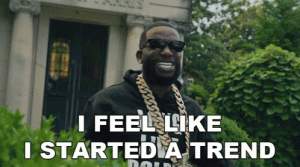
Event Marketing Trends in 2023
Even in 2023, the event marketing landscape continues to evolve and adapt to changing consumer preferences and technological advancements. To stay ahead in this competitive space, brands and event organizers must be aware of the latest trends shaping the event marketing industry. It is time to explore the emerging trends expected to dominate the event marketing landscape this year, providing insights and inspiration for you to create memorable and impactful experiences.
Teaser Videos to Hype the Audience
Have you ever thought you could steal something Hollywood movie productions do with every movie or TV series? Teasers are short promotional videos designed to generate excitement and anticipation for an upcoming event or product launch. They offer a sneak peek into what attendees can expect, creating a sense of intrigue and curiosity.
As mentioned, Hollywood has long used teaser videos to build anticipation for movies and TV series, and essentially, the same concept can be applied to event marketing strategies to create buzz and engage the audience.
By offering glimpses of thrilling scenes, intriguing storylines, or memorable moments, these videos pique the interest of the audience and leave them wanting more. They tap into the power of anticipation, stirring up excitement and generating buzz among fans.
You can leverage teaser videos to promote your events and create a similar sense of anticipation among your target audience. Build excitement and generate curiosity by teasing fundamental elements of the event, such as guest speakers, exclusive content, or unique experiences.
Teaser videos provide an opportunity to highlight the most compelling aspects of the event in a visually captivating and emotionally engaging way.
Creating teasers is particularly beneficial, especially if you are holding annual events. Short and engaging summary videos of what happened at the last event can generate a sense of belonging and entice potential attendees to emerge and be part of the experience.
Several brands have successfully incorporated teaser videos into their event marketing strategies. For example, Apple’s annual product launch events are known for their meticulously crafted teaser videos. These videos showcase glimpses of new products, innovative features, and captivating visuals designed to create anticipation among Apple enthusiasts.
This year Apple released a small teaser for the WWDC 2023.
https://twitter.com/appltrack/status/1661067355047313431?s=20
Incorporating teaser videos into event marketing strategies requires careful planning and execution. Here are some key considerations to get you prepared for your next teaser video:
- Create Intrigue: Craft teaser videos that leave the audience curious and wanting to learn more. Use visually captivating imagery, compelling storytelling, and enticing snippets of content to build intrigue.
- Highlight Unique Aspects: Showcase the event’s most exciting and unique elements to differentiate it from others. Whether it’s special guests, exclusive content, or immersive experiences, emphasize what sets the event apart.
- Build a Narrative: Develop a narrative or storyline that unfolds through the teaser videos. That creates a sense of anticipation and keeps the audience engaged as they follow the story leading up to the event.
- Release in Phases: Consider releasing teaser videos in phases to build anticipation over time. Start with subtle hints and gradually reveal more exciting elements as the event approaches.
If you eagerly want to stand out, you could also do a thank you video after your event, highlighting all the great things that happened – the communities that thrived together, the network opportunities, the keynote speakers, the immaculate workshops, etc. – just like Coachella does every year.
LINK TO COACHELLA’s VIDEO – https://www.youtube.com/watch?v=f12QSMis_AY
Event Hashtags Are the Next Big Thing
Originally a straightforward method for brands to expand their reach, hashtags have evolved into an essential component of social media culture. Even today, they continue to be one of the most effective means for users to categorize and explore content centered around specific topics or themes.
In the event marketing realm, hashtags have emerged as a powerful tool to create buzz, increase visibility, and engage audiences. Let’s explore how event hashtags can take your social media management game to the next level.
Firstly, hashtags unify conversations and content surrounding your event. Unique and memorable hashtags can encourage attendees, sponsors, and participants to share their experiences, photos, and opinions. Boosting engagement, they could also facilitate the discovery of user-generated content related to your event.
Additionally, event hashtags can enhance brand visibility and reach. When attendees and participants use the hashtag in their posts, it expands the event’s reach to their followers and networks. This organic amplification increases exposure, generates interest, and can set the tone for a follow-up event. It also allows you to track and monitor the online conversations and sentiments surrounding your event.
Moreover, event hashtags foster community and engagement. They create a sense of belonging and allow participants to connect and interact with one another. Attendees can join discussions, share insights, and exchange ideas related to the event. This social connection builds a community around your event, fostering loyalty and long-term engagement.
More and more brands utilize hashtags. But not all hashtags work as well as others. In your hashtag brainstorming process, you and your team should brainstorm and come up with an idea that is all unique, short, relevant, and memorable all at once.
Hashtags that have been recently used or are too general won’t do much good for your brand. It needs to be specific for your brand’s event yet memorable enough for people to use it whenever they have something to post about.
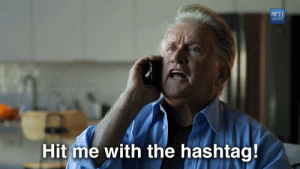
One of the most common brand hashtags for events is making an abbreviation from the event’s name. Some even add the year it is held to make it more distinctive. For instance, #SXSW is the hashtag for The South by Southwest (SXSW) conference and festival use. The hashtag serves as a hub for conversations, event updates, and networking opportunities. It enables participants to stay informed about the event, engage with one another, and share their experiences.
Let’s also talk about Red Bull again. One of the many events the brand hosts is an annual event where participants build and pilot homemade flying machines off a platform into the water. It is called Red Bull Flugtag, and of course, it has its personal hashtag. The event encourages participants and spectators to use the hashtag #RedBullFlugtag to share their funny, creative, and daring moments. The hashtag helps generate buzz, attract attention to the event, and encourage people to join the fun.
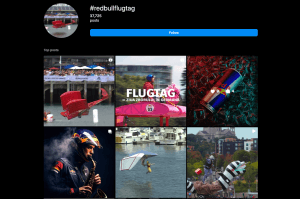
Badges That Will WOW the Attendees
Every little detail plays a crucial role in creating a memorable and engaging experience for attendees. The event badge is an often overlooked element that can significantly impact attendees’ perception of an event. Traditionally seen as a simple identification tool, event badges have evolved into a creative and visually appealing aspect of event branding.
By designing unique, visually stunning, and share-worthy badges, you can elevate the overall event experience, using that as a way to create a buzz on social media platforms.
In today’s visually-driven society, aesthetics hold great importance. Attendees are constantly seeking photo-worthy moments to capture and share on their social media profiles. That is where designing badges that stand out and are visually appealing can make a significant difference.
A well-designed badge can become a conversation starter, prompting attendees to take photos and share them on their social media accounts. This user-generated content acts as free advertising, spreading the word about the event to a wider audience and showing social proof of your credibility in your respective industry.
So how do you create badges that will WOW the attendees? The short answer: follow your brand playbook. But let’s get into a little more detail.
- Eye-catching Colors: Opt for vibrant and bold colors that catch the eye and make the badge visually appealing. Align the color scheme of the badge with the overall event branding to create a cohesive and visually striking look.
- Unique Shapes and Materials: Move away from the traditional rectangular shape and explore unconventional badge shapes like circles, triangles, or custom die-cut designs. Incorporate uncommon materials like metallic finishes, holographic elements, or textured surfaces to add a touch of luxury and intrigue.
- Brand Logo and Messaging: Ensure the badge notably features the brand’s logo and event messaging. That reinforces brand recognition and helps create a lasting impression in attendees’ minds.
- Personalization: Add a personal touch to each badge by including the attendee’s name or a custom QR code with a secret discount code or another prize of your choice. That makes attendees feel valued and creates a sense of exclusivity.
- Functional and Interactive Features: Integrate practical features into the badge design, such as NFC technology for contactless check-ins or QR codes that lead to interactive experiences or exclusive content.
Our last point about functionality and interactiveness is the future. So you’d better keep an eye out for it. If your budget allows it, investing in smart badges could be a terrific opportunity to impress attendees. You could program them to work as self-checkers to different checking points in your event location.
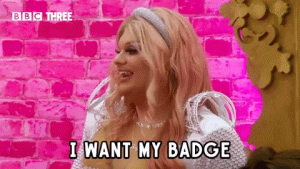
Incorporate a range of advanced functionalities, such as contact sharing and cashless payments, even in the absence of multiple checkpoints, to enhance the user experience. It is a great way to facilitate networking opportunities and encourage face-to-face interactions among attendees, reducing reliance on mobile devices.
In the end, you could collect back the badges, providing attendees with all the contact info they’ve exchanged throughout the event’s duration. We promise everyone will be impressed at your innovative approach, recording and sharing their experiences over social media.
Yet, even if you can’t go with smart badges due to budget or other restraints, there are more ways to impress your audience. After all, there’s plenty of room to unleash your creativity as far as badges are concerned. If you are a sustainable brand hosting an event, make your badges from recycled materials and with nature and eco-friendliness in mind.
You could also combine the badge with the event’s program to minimize further footprint and keep attendees’ hands-free to make new contacts and explore all opportunities freely.
Reward Early Birds With Discounts for the Next Event
Rewarding early birds with discounts for the next event is a strategic approach, a trend here to stay, that can help generate excitement and anticipation among attendees. By offering exclusive discount codes or special pricing to current attendees, you show appreciation for their support and create a sense of loyalty and incentive for them to participate in future events.
This tactic can be a powerful marketing tool to drive ticket sales, build a community of dedicated attendees, and boost overall event success.
One of the primary advantages of offering discounts to early bird attendees is the ability to create a sense of exclusivity. By providing a limited-time offer or a reduced price for future events, you make attendees feel privileged and valued. That can encourage them to become brand advocates, spreading the word about your event and attracting more participants.
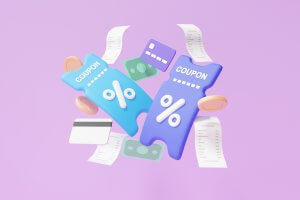
Additionally, the prospect of securing a discounted ticket for the next event motivates attendees to plan and commit to attending, increasing the likelihood of repeat attendance.
To effectively implement this strategy, it’s essential to communicate the discount offer during the current event. Consider leveraging various channels such as email marketing, social media, and on-site announcements to inform attendees about the exclusive discount available to them.
Creating a sense of urgency, or generating FOMO, by highlighting the limited availability or the offer’s time-bound nature can further incentivize attendees to take advantage of the discount and secure their spots for the next event.
When providing discount codes, ensure they are easy to use and well-communicated. Simplify the redemption process by offering a dedicated webpage or a custom registration form where attendees can easily enter the discount code and receive the discounted rate. This seamless experience will further enhance attendee satisfaction and increase their likelihood of taking advantage of the offer.
Furthermore, highlight the value attendees will receive by attending future events. Emphasize any new and exciting features, speakers, or planned activities, showcasing how their participation is to be rewarded.
For example, you can tease upcoming keynote speakers, workshops, or exclusive networking opportunities. Not only does this entice attendees to secure their discounted tickets, but it also builds anticipation and excitement for the future event.
To maximize the impact of this strategy, track and analyze the effectiveness of your discount offers. Monitor the redemption rates, ticket sales, and attendee feedback to evaluate the campaign’s success. This data will provide insights into the effectiveness of your discount strategy and help refine future marketing efforts.
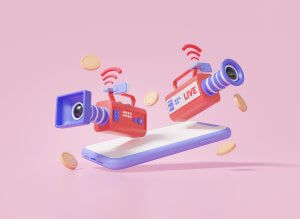
Livestream High-Demand Lectures
Our next trend is something we already mentioned briefly before. Some lectures and talks might have a tremendously high demand and be the only reason for some people to attend. Live Streaming them online is a strategic approach that allows you to reach a wider audience and make your content accessible to those unable to attend in person.
One of the main advantages of live-streaming high-demand lectures is the ability to overcome geographical limitations. By broadcasting in real-time to an online audience, you can connect with individuals anywhere in the world who may not have the means or opportunity to attend the event physically. That opens up new possibilities for knowledge sharing, collaboration, and networking on a much global scale.
People can participate from the comfort of their own homes or offices, eliminating the need for travel arrangements and expenses. This accessibility factor is particularly beneficial for professionals, students, or individuals with busy schedules who may find it challenging to attend events in person.
Moreover, live-streaming high-demand lectures can generate a sense of excitement and exclusivity. When attendees know that a lecture will be live-streamed, it creates a buzz and anticipation among both – the physical and online audience. This exclusivity can drive higher engagement, attract a larger audience, and position your event as a valuable source of industry knowledge.
Promotion plays a critical role in maximizing the impact of live-streamed lectures. Leverage your marketing channels, such as social media, email newsletters, and event websites, to inform your audience about the live-streaming option. Highlight the benefits of attending virtually and emphasize the value of the content being shared.
Encourage online participants to engage in real-time by asking questions, participating in polls, or using designated hashtags for discussions. This interaction creates a sense of community and involvement, even for remote attendees.
After the event, consider making the recorded livestream available for on-demand viewing. That allows individuals who missed the live broadcast to access the content at their convenience and further extends the reach and longevity of your lecture.
You can even sell tickets for your live-streamed lecture. Add another benefit or two to make your offer more appealing to virtual attendees. However, if you decide your live-streamed talk to be paid, you need to invest in reliable and user-friendly streaming technology.
Choose a reputable live-streaming platform offering high-quality video and audio capabilities to ensure a seamless viewing experience for remote attendees. Test the streaming setup before the event to address any technical issues and ensure a smooth live-streaming process.
You don’t want people to feel dissatisfied with their experience, leaving negative reviews all around and giving your brand a bad reputation. Yet, if anyone is feeling disappointed, be ready to activate your brand reputation management game. Listen to the attendees’ feedback and, if possible, compensate them.

Virtual Reality Events
Lastly, we have one of the latest trends – immersive technology events. Virtual Reality (VR) is an immersive technology that simulates a computer-generated environment, enabling users to interact with and experience a virtual world.
It can revolutionize the event industry by offering unique and engaging experiences that transcend physical limitations. With VR, brands can create unforgettable virtual events that elevate their brand image, connect with audiences in new ways, and provide immersive experiences that leave a lasting impression.
One of the key advantages of virtual reality events is the ability to break free from the constraints of physical space and location. Regardless of where attendees are geographically, they can participate in a virtual event from the comfort of their own homes or offices.
That opens up a world of opportunities for brands to reach a global audience and engage with individuals who may not have been able to attend a physical event due to travel limitations, time constraints, or other barriers.
Virtual reality events provide a level of interactivity and immersion that traditional events will never match. Attendees can explore virtual environments, interact with virtual objects, and engage in activities that replicate real-world experiences.
Such immersion creates a sense of presence and engagement that captures attendees’ attention and keeps them fully engaged throughout the event. From virtual product demonstrations to interactive workshops and virtual networking spaces, you can create tailored experiences that align with your objectives and resonate with your target audience, constantly wowing them and creating unique experiences they won’t quickly forget.
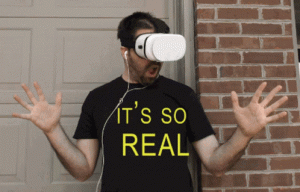
What better way to showcase your innovative and forward-thinking nature than hosting a virtual reality event? It demonstrates a commitment to embracing new technologies and providing cutting-edge experiences for the audience.
You can elevate your brand’s image and position yourself as an industry leader willing to push boundaries and deliver exceptional experiences. All of that can result in increased brand loyalty, positive brand perception, and a competitive edge in the market.
Several brands have already embraced virtual reality events with great success. For example, Oculus, a leading VR company, organized Oculus Connect, an annual developer conference that brings together VR enthusiasts, developers, and industry professionals.
The event features keynote presentations, hands-on demos, and interactive sessions, all delivered in a virtual reality environment. Oculus Connect has become a highly anticipated event in the VR community, showcasing the latest advancements in VR technology and fostering collaboration among attendees.
Another notable example is the Tribeca Film Festival, which introduced a Virtual Arcade section to showcase immersive VR experiences. Attendees can explore virtual worlds, watch VR films, and engage with groundbreaking VR content. The integration of virtual reality has enhanced the festival’s offerings, attracting a wider audience and bringing immersive storytelling to new heights.
As technology continues to evolve, virtual reality events will undoubtedly become a mainstay in the event industry, offering new possibilities and pushing the boundaries of what is possible in the realm of experiential marketing.
Time-Tested Tips and Tricks for Your Event
Not all strategies are new trends that have emerged. We have compiled a collection of some time-tested tips and tricks that can help you make the most out of your upcoming event. Whether you’re organizing a conference, trade show, or corporate gathering, these insights will provide valuable guidance to ensure a seamless and memorable experience for your attendees.
Give Free Invites / Tickets

Offering free invites or tickets as a promotional strategy can be a highly effective way to generate buzz and attract a larger audience to your event. People love the opportunity to win something for free! Giveaways create a sense of excitement and anticipation that are so difficult to ignore that most people give in and participate.
Furthermore, it provides you with the terrific opportunity to raise those engagement rates by (hopefully) getting many people to participate for the free passes to the event and only a few obtaining the prizes.
Depending on your niche and industry, you might already have experience throwing giveaways on social media or other platforms. Yet, here are some key considerations when organizing a free invite or ticket giveaway:
- Decide on a platform: Select channels where you can run the giveaway effectively, such as social media platforms, email newsletters, or your event website. Consider the platforms your target audience is most active on to maximize participation.
- Set clear entry rules: Clearly outline the rules and requirements for entering the giveaway. That could include sharing a post, tagging friends, or submitting an entry form. Ensure that the entry process is simple and user-friendly to encourage participation.
- Create a sense of urgency: Always set a specific timeframe for the giveaway to create a sense of urgency and encourage immediate action. Limited-time offers often drive higher engagement and participation.
- Consider your timing: Depending on giveaway goals, brand recognition, event attendance, etc., when you host your promo giveaway will matter. Carefully pick the best time for your ticket giveaway regarding factors and other KPIs you usually track.
- Offer enticing prizes: Undoubtedly, the value of what you offer individuals as an incentive plays a crucial role in their willingness to participate. Choose rewards that are relevant and valuable to your target audience. That could include VIP passes, exclusive merchandise, backstage access, a 1-on-1 meeting with the keynote speaker, or any other unique experiences related to your event.
- Promote the giveaway: As you can guess, the more you promote the giveaway, the more participants you will get. Use various marketing channels to promote the giveaway, such as social media posts, email campaigns, website banners, and paid advertisements. Leverage the power of visuals and compelling messaging to capture attention and generate interest.
- Follow legal regulations: Always a must for every brand, whether a B2B or B2C eCommerce store, familiarizing yourself with any legal regulations or guidelines regarding giveaways in your jurisdiction is a must you should never miss. Ensure that your giveaway complies with all necessary rules and regulations.
Giveaways are not only about attracting participants but also about creating a positive brand experience. Engage with participants throughout the giveaway period, respond to their comments and inquiries, and maintain transparency in the selection process.
Think as an Attendee

Something that always rises to the occasion and has helped a lot for many of the events we’ve been involved with is putting ourselves in attendees’ shoes. As basic or bland as it sounds, adopting the audience’s perspective will shift your point of view and direction of any event you organize and host.
After all, why bother throwing an event people don’t need to attend? By thinking as an attendee, you can gain valuable insights into what people need, want, and expect from the event experience. What we call an empathetic approach to event marketing has proven, time and time again, to allow brands to create an event that resonates with attendees and leaves a lasting positive impression.
Imagine you were an attendee – what would you hope to gain from the event? You know your audience best, so consider their interests, goals, preferences, and needs. People are ready to pay a lot if they think they will gain something back in return. So, what content, activities, or experiences would they find valuable and engaging? Think of all that and tailor the event to meet their needs.
You will understand the importance of creating a seamless experience throughout all the events only when you imagine the whole attendee journey – from registration to post-event follow-up. Evaluate every touchpoint and interaction to ensure a seamless and enjoyable experience.
Would you wait 3 minutes for the registration form to load or 10 minutes to complete your transaction? Your attendees’ time is as valuable as yours. Ensure efficient logistics of all kinds to minimize potential frustrations for everyone involved.
Understanding your attendees’ educational needs will help you decide what to include in your program. Attendees seek educational, inspiring, and informative content. Offer diverse presentations, workshops, and interactive sessions that address their interests and provide tangible takeaways. Focus on quality over quantity and curate thought-provoking yet engaging and fun content for your people.

Many people visit professional events to connect and communicate with like-minded individuals and work on nurturing new relationships with others in their fields. Foster networking opportunities by creating opportunities for attendees to connect and engage with industry experts and potential collaborators. Some examples might include structured networking activities, facilitated informal conversations, and dedicated spaces for networking to enhance the overall attendee experience.
Usually, events are long-lasting, so who wouldn’t want to be comfortable for most of their day? Comfortable seating arrangements, ample restrooms, and accessible facilities might set the tone for a more positive experience for all present attendees. Offer amenities such as water stations, charging stations, and Wi-Fi access to enhance the overall event experience.
Focus on creating a more attendee-centric event to leave a lasting impact on attendees, building strong relationships for the future.
Share Highlights
With professional events, there is always something remarkable going on. A keynote speaker could present a revolutionary concept at one corner, and an industry expert could hold an advanced workshop at the opposite. With that in mind, attendees can’t be at all places simultaneously. While they might be more than happy to attend one of the two, they might still want to learn what happened at the other.
That’s where sharing highlights can come in handy. Apart from using it to shed light on parts some attendees might have missed, it is also a powerful way to create buzz and extend the reach of your event’s impact.
By being present during the event, documenting the experience, and sharing it on social media, you can engage both attendees and a wider audience, creating a sense of excitement and interest.
You know about the fear of missing out, don’t you? Sharing highlights allows you to showcase your event’s unique and memorable moments. By capturing and sharing captivating photos, videos, behind-the-scenes content, or summary posts, you can create a sense of exclusivity and excitement that makes others wish they were there. This FOMO can drive anticipation for future events and increase attendance.
With social media platforms as your best friend, you can amplify the reach of your event. When attendees share their experiences, insights, and favorite moments, their diverse groups of followers, friends, or colleagues become exposed to your event, potentially reaching a broader audience that may not have been aware of it initially. This organic sharing can help expand your event’s visibility and attract new attendees or participants for future events.
Furthermore, by featuring their own content or encouraging them to share their favorite moments, you foster a sense of community and participation among attendees. This engagement can strengthen their connection to your brand and event, increasing loyalty and future participation.
Highlighting key moments and impactful content from your event allows you to demonstrate the value and impact of attending. By sharing testimonials, insights, or success stories, you can showcase the benefits and outcomes that attendees have gained from participating in your event. This social proof can help attract future attendees seeking similar experiences and outcomes.
It is also a perfect way to keep the momentum going and extend the lifespan of your event’s impact. By continuing to share valuable content, key takeaways, or highlights from presentations or discussions, you keep attendees and potential attendees engaged, interested, and connected to your brand. This sustained engagement can lead to ongoing conversations, partnerships, or opportunities beyond the event.
Keep it Safe
Ensuring the safety of attendees is of utmost importance when organizing an event. By taking proactive measures and implementing robust safety protocols, you can create a secure and comfortable environment for all participants.
With the pandemic now behind our backs, we can all appreciate the importance of sanitary measures. Back in the day, no event could occur without strict protocols and COVID-19 measures. Closely follow through with health authorities’ guidelines and recommendations even if no pandemic is there to haunt your event.
Consider providing hand sanitizers, face masks, or other personal protective equipment to promote good hygiene practices. Maintaining a clean and hygienic environment is crucial for the well-being of attendees. Plan for regular cleaning and disinfection of the event venue, paying extra attention to frequently touched surfaces.
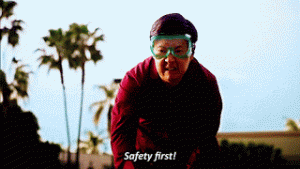
Safety goes beyond health precautions. Assess the security needs of your event and work with professional security personnel to ensure a safe environment. That may include implementing bag checks, access control measures, and having trained staff to handle emergencies. Communicate the presence of security personnel and any safety protocols to attendees to foster a sense of security.
Proper crowd management is essential to prevent overcrowding and maintain a safe environment. Evaluate the capacity of your event space and plan for adequate space between attendees. Utilize crowd control barriers, signage, and floor markings to guide the flow of people and ensure social distancing measures are followed.
Effective communication plays a crucial role in ensuring attendee safety. Use various channels, including your event website, social media platforms, and pre-event communications to communicate the safety measures and protocols. Use signage and announcements during the event to remind attendees of safety protocols and provide guidance on proper behavior.
Work closely with the event venue and vendors to ensure they share your commitment to safety. Confirm that the site has implemented appropriate safety measures and has the necessary facilities to support health protocols. Communicate your expectations to vendors, such as food vendors or equipment suppliers, regarding their adherence to sanitary practices.
Stay vigilant and continuously monitor the event for any potential risks or issues. Regularly assess the effectiveness of your safety protocols and make necessary adjustments as needed. Stay informed about any updates or changes in local health guidelines and adapt your measures accordingly.
By implementing a comprehensive safety plan and prioritizing the well-being of attendees, you can create an environment where people feel secure and comfortable.
Track Event Marketing KPIs
No better way to measure the success and impact of anything marketing-related, including events, than tracking key performance indicators (KPIs). By monitoring and analyzing relevant metrics, you can gain valuable insights into the effectiveness of your strategies, make data-driven decisions, and optimize your future event marketing campaigns. Here are a few crucial KPIs we always make sure to track:

Check-ins & Registrations
This one might be obvious, but many overlook the importance of monitoring the number of check-ins and registrations for an event. This metric provides insights into the level of interest and attendance. By tracking registrations, you can gauge the effectiveness of your marketing channels and campaigns in driving audience engagement.
Additionally, analyzing check-in data during the event can help you understand attendee behavior, identify popular sessions or activities, and optimize the event experience in real time.
To track check-ins and registrations effectively, utilize event management software or ticketing platforms that provide comprehensive reporting and analytics. These tools enable you to monitor registration numbers, track conversion rates, and gather attendee data for future targeting and engagement.
Return on Investment (ROI)
Measuring the return on investment (ROI) of your event marketing is crucial for assessing the financial success and overall impact of your efforts. ROI helps you determine whether your marketing activities are generating positive returns and aligning with your business objectives. To calculate event marketing ROI, compare the total revenue generated from the event with the associated costs, including marketing expenses, venue fees, and production costs.
To track ROI, consider implementing a robust event tracking system that captures revenue data, such as ticket sales, sponsorship income, and merchandise sales. Additionally, conduct post-event surveys or interviews to gather data on attendee spending patterns and potential business opportunities generated due to the event.
Media Coverage & Influencer Data
Monitoring media coverage and press mentions of your event is crucial for evaluating its visibility and reach. Media coverage can generate valuable exposure, attract new audiences, and enhance your brand’s reputation. Track the number of articles, interviews, blog posts, social media mentions, and other forms of media coverage related to your event.
To track media coverage effectively, set up Google Alerts or use media monitoring tools to receive notifications whenever your event is mentioned online. Monitor social media platforms, industry publications, local newspapers, and relevant online forums for mentions and discussions about your event.
Analyze the sentiment and reach of media coverage to understand its impact on your event’s overall perception. Regularly analyze the collected media coverage data to identify trends, assess the effectiveness of your PR and media outreach efforts, and refine your strategies for future events.
When collaborating with media influencers or industry experts to enhance the reach of your event and increase media coverage, it is advisable to optimize your contracts to include obligations for providing tangible data on the performance of their posts and content. This approach not only enables you to track the impact of your event but also offers insights into the effectiveness of your influencer marketing strategy. By incorporating these provisions into your contracts, you can assess whether the collaboration is yielding satisfactory results.

Including a requirement for real data from influencers allows you to measure the reach and engagement of their social media posts, blog articles, or other content related to your event. This data could include metrics such as impressions, clicks, likes, shares, comments, and conversions.
To implement this approach effectively, clearly outline the data reporting expectations in the contract. Specify the frequency and format in which influencers are required to provide the data. Additionally, consider incorporating provisions for monitoring and auditing the provided data to ensure its accuracy and reliability. By doing so, you can maintain transparency and accountability in your influencer collaborations.
Analyzing the data provided by influencers allows you to evaluate their content’s success and the impact it has on your event’s visibility and audience engagement.
You can identify which influencers are driving the most significant results and adjust your future influencer marketing strategies accordingly. Furthermore, the data collected can help you assess the overall effectiveness of your event marketing campaigns and make informed decisions for future collaborations.
When Should You Start Planning?
The short answer here is that there’s no better day than today.

Ever heard of the old saying: “The early bird catches the worm?” Because it holds true as far as event planning goes. Starting the planning process well in advance is crucial for a successful event. It allows you to allocate sufficient time for all the necessary tasks and ensures a smooth execution. So, how early should a brand start planning?
While there’s no definite answer to that question, you should start as soon as you decide on throwing an event. That provides ample time to set clear goals, develop a comprehensive event strategy, and gather all the needed resources.
It allows you to establish a well-defined roadmap and effectively allocate tasks to your team. And you want to avoid the stress and last-minute rush that often leads to oversights and compromises, don’t you?
Ideally, event planning should commence six to twelve months before the actual event date. This timeline allows you to accomplish crucial tasks such as venue selection, budgeting, speaker or entertainment bookings, and marketing strategies.
You also have the flexibility to adjust and adapt to unforeseen circumstances, ensuring you have enough time to handle any potential challenges.
Great and popular venues are always booked far in advance. By starting early, you can secure desirable venues and negotiate better contracts and prices, securing favorable terms with vendors and suppliers.
Furthermore, marketing strategy development doesn’t happen overnight. Creating a comprehensive marketing strategy, including digital and traditional channels, and having sufficient time to execute each element effectively takes more time than one would initially imagine. After all, your marketing strategy will ensure maximum visibility and attendance for your event.
Looking for partnerships, collaborations, or sponsors is also timely. You can identify potential sponsors, speakers, or exhibitors and initiate discussions well in advance. Establishing these relationships early on allows for better coordination, leveraging their networks and expertise to enhance your event’s success.
So, don’t delay—start planning early and lay the foundation for a successful event journey.
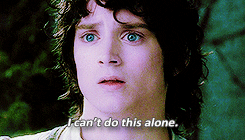
Can Socialfix Help?
The short answer is: Yes. And here’s how. We’ve worked with many B2B or B2C brands, helping them in their event marketing efforts. Being so long on the market, we’ve developed a deep understanding of digital marketing strategies tailored to specific brand goals and target audiences.
We can support your event marketing journey each step of the way – from doing your strategic plan for you and generating written, visual, and video content to creating a landing page and promoting you on social media.
We can develop customized event marketing strategies for your business to generate buzz, increase brand awareness, and drive audience engagement. Whether it’s a trade show, conference, product launch, or any other event type, at Socialfix, we can devise a tailored plan that aligns with your brand’s objectives.
Crafting compelling content, optimizing landing pages, and implementing lead-generation tactics are just some things we can do to help drive qualified leads and enhance brand visibility within the B2B space. Similarly, for B2C brands, we can harness our expertise in social media marketing, content creation, and influencer partnerships to create captivating campaigns that resonate with the target consumer base.
We can develop engaging social media content, implement paid advertising strategies, and leverage influencers to create excitement around the event. With our creative approach, we can help brands connect with their target audience on a deeper level and generate interest and attendance for the event.
Acknowledging the significance of post-event content, we understand the value of being present during the event. We are dedicated to capturing all the special moments of each talk, session, workshop, or any other engaging activity in action. We ensure that no fundamental moment goes unnoticed and that all the highlights are documented for future use.
We will capture speakers’ and attendees’ energy, excitement, and priceless insights. Not only are these moments valuable for documenting the event itself, but also for creating compelling follow-up content you can share across various channels.
Mastering the art of word-of-mouth storytelling, we can conduct interviews with speakers, panelists, and attendees during the event to gather testimonials, insightful quotes, and personal experiences. By showcasing the perspectives and experiences of those involved, you can amplify the impact of your event and generate further interest from your audience.
Wrapping Up
While our discussion on event marketing has been nothing short of a thrill, it is now time to delve into the concluding section of our second part. Your main takeaway should be that implementing a well-crafted event marketing strategy allows you to effectively reach your target audience, create buzz and excitement, and ultimately drive attendance and engagement.
From setting clear goals to curating compelling content, from utilizing social media to incorporating new technologies like virtual reality and teaser videos, you can now have a multitude of strategies and tactics at your disposal to create impactful and memorable events.
It is important to remember that event marketing is an ongoing process that requires continuous evaluation and adjustment. By tracking key performance indicators (KPIs) and analyzing the success of different marketing strategies, you can refine your approach and make informed decisions for future events.
In a rapidly evolving digital landscape, staying up-to-date with the latest event marketing trends and techniques is crucial. Be open to embracing new technologies, exploring innovative ideas, and adapting your strategies to meet your target audience’s ever-changing needs and expectations.
Now you are finally ready to spread your wings, sprinkle some magic and host a kick-ass event for your brand!
